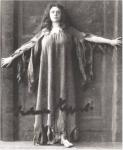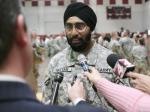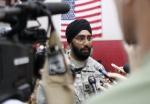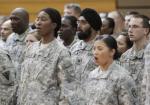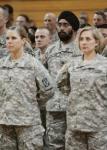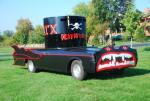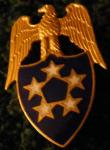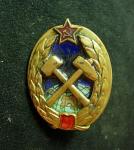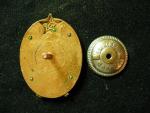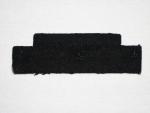-
Posts
7,998 -
Joined
-
Last visited
-
Days Won
2
Content Type
Profiles
Forums
Blogs
Gallery
Events
Store
Everything posted by Hauptmann
-
Hoping this helps. Got this from this site and if you go there there's a link to hear her sing - http://www.cantabile...c_sopranos.html Gertrude Kappel (1884 - 1971) <P align=left>Biographical notes: Gertrude Kappel was born in Halle. Like Marta Fuchs, she began her studies as a contralto, but soon changed to a soprano, making her debut in 1907 as Leonore at the Hoftheater Hanover, where she was engaged until 1921. From the beginning of her career she concentrated on dramatic roles. From 1922 - 1927 she was engaged by Richard Strauss at the Vienna Staatsoper where she became an admired member of the company. At Covent Garden she appeared from 1912 - 1914 and returned in 1924 - 1926. Her roles included Brünnhilde, Isolde, Sieglinde, Senta, the Marschallin and Elektra, as well as a few roles of the Italian and French repertory. In London Gertrude Kappel faced strong competition with the great Frida Leider. She appeared at the Salzburg Festival, where she sang Donna Anna (1922) and at the Munich State Opera from 1927 - 1931. She made her Metropolitan debut in 1928 as Isolde, subsequently singing her most important roles: Ortrud, Fricka, Brünnhilde, the Marschallin and Elektra (first Metropolitan performance in 1932). Her art was unfortunately overshadowed by the singing of Kirsten Flagstad and Marjorie Lawrence. She repeated Isolde at San Francisco in 1933 and retired in 1937. She died in her home near Munich in 1971. As Brünnhilde in "Die Walküre" As Octavian As Elektra Charles B. Mintzer (pictures)
-

1st Sikh in decades graduates Army officer school
Hauptmann replied to Hauptmann's topic in United States of America
-
http://news.yahoo.co...zdHNpa2hpbmRlYw-- 1st Sikh in decades graduates Army officer school U.S. Army Capt. Tejdeep Singh Rattan, center wearing turban, stands with other graduates during a U.S. Army officer basic training graduation ceremony at Fort Sam Houston in San Antonio on Monday, March 22, 2010. Capt. Rattan is the first Sikh allowed to complete officer basic training while wearing the traditional turban and full beard since the Army altered the dress code, which had made exceptions for Sikh soldiers, in 1984.(NOTE: all photos - AP Photo/Darren Abate) By MICHELLE ROBERTS, Associated Press Writer Michelle Roberts, Associated Press Writer 1 hr 37 mins agoSAN ANTONIO The soldiers in standard-issue fatigues and combat boots stood side-by-side repeating their creed: "I am an American soldier. I am a warrior and a member of a team. I serve the people of the United States and live the Army values ...." Capt. Tejdeep Singh Rattan was no different except that he wore a full beard and black turban, the first Sikh in a generation allowed to complete U.S. Army basic officer training without sacrificing the articles of his faith. He completed the nine-week training Monday after Army officials made an exemption to a policy that has effectively prevented Sikhs from enlisting since 1984. "I'm feeling very humbled. I'm a soldier," said the 31-year-old dentist, smiling after the ceremony at Fort Sam Houston. "This has been my dream." Rattan had to get a waiver from the Army to serve without sacrificing the unshorn hair mandated by his faith. An immigrant from India who arrived in New York as a teenager, Rattan said he hopes his military commitment will allow him to give back to his adopted home country and will help diminish prejudice Sikhs sometimes face in the U.S. The Army in 1984 eliminated an exemption that had previously allowed Sikhs to maintain their articles of faith while serving, but officials can issue individual waivers to the uniform policy after considering the effects on safety and discipline, said Army spokesman George Wright. Only a handful of such individual religious exemptions are ever granted. Rattan and Dr. Kamaljeet Singh Kalsi, who will attend basic training this summer after completing an emergency medicine fellowship, are the first Sikhs to receive exemptions in more than 25 years. Rattan who received a master's degree in engineering before pursuing a dental education_ and Kalsi both offer health care skills that are in high demand in an Army stretched by wars in Afghanistan and Iraq. Rattan said he encountered no trouble from fellow soldiers during training. "The Army is all about what you have to offer. If you're sitting back there, not doing anything, they're definitely going to talk about you. But if you're up there running with them, you have good scores, you run neck-and-neck with them, they love you," he said. "I made a lot of friends." 1st Sgt. Jeffrey DeGarmo said he made sure the officers-in-training in his unit understood that Rattan wasn't a foreign national and had received the Army's permission to maintain his beard and turban. Once the other soldiers understood that, there were no issues, he said. "It went pretty well," DeGarmo said. "I think he did an outstanding job adjusting." During training, Rattan wore a helmet over the small turban, which he doesn't remove, and was able to successfully create a seal with his gas mask despite the beard, resolving the Army's safety concerns, said Harsimran Kaur, the Sikh Coalition's legal director. Rattan also worked with an Army tailor to create an insignia patch normally worn on soldiers' berets that could be affixed to his black turban, she said. An estimated 300,000 Sikhs live in the United States. The unshorn hair wrapped in a turban and beard are required to keep adherents in the natural state in which God made them, said Amardeep Singh, director of the Sikh Coalition, a New York-based advocacy group that helped Rattan and Kalsi push for Army admittance. The Sikh community has a long tradition of military service in India, from where most adherents originally emigrated, and in other countries, such as the United Kingdom and Canada. Sikhs represent 2 percent of India's population but make up about 30 percent of that country's army officers, Singh said. Before the Army's regulation change in 1984, Sikhs served in the U.S. military during every major armed conflict going back to World War I. Those who joined before the change were allowed to serve with their beards and turbans, but the policy effectively prevented new enlistment of Sikhs, Kaur said. The coalition continues to push the Army to change the overall policy. "If government can say to someone, 'You can't serve, not for any reason that has to do with your abilities,' that sends the wrong message," Singh said. "We don't want to be perpetual outsiders."
-
I tend to agree that they were probably only used by the army. From what I remember navy uses aiguillettes for the various types of aides. Not sure about the other branches. Again it's something that's a bit outside my areas of interest... ie: I know enough to be dangerous. My thought on them still being available though was based on my having seen such things as the airship wings, balloon corps wings, etc., that are still ofered for collectors, museums, etc. But it may be that they are indeed no longer available. Anyhow as I learn more about the grouping, etc., I'll post updates. Thanks! Dan
-
Update: My friend just got me the correct name of the individual who originally had this device. But so far I can't find much of anything on the web. Brigadier General Richard I. Braund If anyone has any info on him and whether he was at some time an aide to a 5 star please let me know. Also this is apparently a group and not just the one device. No idea yet what all is included. Comes from the family. If I can find out more I'll post more updates. Thanks! Dan
-
Hi all, Asked about this by a friend. Sorry I don't have a decent pic of the reverse but it's also gold with the standard pin back that the little round brass clasps go on. It's marked G23. This insignia for an aide to a U.S. General of the Army (or Fleet Admiral) supposedly belonged to a General Braun. Only one I could find on a web search is: http://www.arlingtoncemetery.net/gjbraun.htm I've written back to ask if there is any documentation with this piece (don't know if it's the single insignia or a pair) as of course otherwise it's just a story as I explained to him in my reply. I know that aide insignia are still plentiful and available on Ebay as well as from various other sources including companies that such military insignia. I couldn't find a five star on a quick search but assuming they're still produced and sold as well for about what the others would run. So assuming that if I'm correct in all this that with no documented history behind it it would not be worth much especially by itself... is this correct? Now... "if" it is documented to the above General or another officer specifically who was indeed an aide to a 5 star then I'm assuming it would then have a bit of value... if so roughly how much? This is just rather outside my usual areas of interest so I'm flying pretty much blind here and any help would be deeply appreciated! Dan
-

Soviet Honored Coal Miner of the CCCP
Hauptmann replied to Christian Zulus's topic in Russia: Soviet Orders, Medals & Decorations
Update: I did just find another one on collectrussia.com. Listed as Mining Engineer Institute (Graduation badge?) Circa 1950's - 1960's. Dan -
Bayonet Drill Dies Of Boredom March 17, 2010: The U.S. Army has finally eliminated bayonet drills from basic training. While the bayonet, and the bayonet charge, have a firm place in military history, the reality is rather different. Bayonets are still carried, but rarely attached to the front of a rifle. Most modern bayonets are simply knives, which are handy for all sorts of things on the battlefield. Sticking them in the enemy is rarely one of them. So training new recruits in the battlefield use of the bayonet is misleading and a waste of time. Why do infantry continue to carry a bayonet? To a certain extent, carrying a bayonet is tradition, but there are practical reasons as well. A lot of time is spent out in the field, and a knife is useful for cutting stuff. But perhaps the most effective military use is intimidation. This is nothing new, the fearsome effect of a bunch of guys advancing with bayonets on the end of their rifles has been known for centuries. It's also a morale boost for the lads using the bayonets. When you hear the order "fix bayonets" (put them on the end of your rifle) you know it's do or die time. Unfortunately, that very rarely happens anymore. The most common "combat" use of bayonets is for crowd control. In fact, this is about the only "bayonet training" most troops get anymore. The bayonet is used somewhat differently in these situations. For one thing, the troops don't just rush at the crowd carrying their bayonet tipped rifles. They march forward, neatly lined up, with the rifles held so that the crowd sees a line of bayonets coming at them. The troops do this while marching in step, and are trained to bring their right feet down as heavily as possible. The sight of the advancing troops, the bayonets and the rhythmic thud of boots striking the ground usually causes the crowd to scatter. Meanwhile, the army has done some work in developing a more effective replacement for the bayonet. Sort of. Three years ago, after several years of research and field testing, the U.S. Army bought 38,000 M26 12 Gauge Modular Accessory Shotgun Systems (MASS). The M26 weighs less than three pounds (2 pounds, 11 ounces) and has a five round magazine. This mini shotgun is mounted beneath barrel of your assault rifle. The M26 is a 16.5 inch long, 12 gauge shotgun and can be operated right or left handed. It fires solid shot for blasting open closed doors, or lower velocity, non-lethal (most of the time) rubber slugs for dealing with hostile crowds without killing people. A stand-alone version weighs 4 pounds, 3 ounces, and is 24 inches long (with the attached stock collapsed). The first versions of this weapon weighed nine pounds and carried only three rounds. The design rapidly evolved into the current M26. Troops have been testing it in combat for about a year. There were complaints about the cocking mechanism, which uses a bolt instead of a pump action (which many troops expressed a preference for.) The final design improved the cocking mechanism, and the reliability of the magazines. Before the M26 came along, troops used a conventional (Mossberg) 12 gauge shotgun for getting locked doors open in a hurry. Many still do. The M26 proved very reliable during testing, with over 15,000 rounds being fired. Large quantities of the M26 reached troops two years ago, after the demand for them in Iraq had largely abated. There was not as much demand for such a weapon in Afghanistan. Makes for a hell of an assault rifle accessory, though. Original link: http://www.strategypage.com/htmw/htinf/articles/20100317.aspx
-

Kriegsmarine Claus Jacob
Hauptmann replied to DDD777's topic in Germany: Third Reich: Research, Documentation & Photographs
Congrats on a terrific group plus many thanks for sharing the addition history. This uprising was something I didn't know about. A great story! Again many thanks for sharing all this! Dan -

Soviet Honored Coal Miner of the CCCP
Hauptmann replied to Christian Zulus's topic in Russia: Soviet Orders, Medals & Decorations
Finally another new addition to my very small Soviet Miner collection. Vitaly calls it an Honorable Excellent Miner badge. So far I've not been able to find another on the web. He says it's brass and enamel and a nice hefty little badge. Looks very well constructed. Needless to say I can't wait to see it in person. Dan -
I'd absolutely love to see photos... but so far I've not been able to find any on the web. I have however found a couple of references to other prominent Germans at the time being giving swords by the Japanese but not the Emperor specifically. Generaloberst Eduard Dietl received the 1 Schwert des japanischen nationalen Verbandes Shochoku Seishin Shinkokai on 18 June 1943. SOURCE: Thomas, Franz & Wegmann, Günter. Die Ritterkreuzträger der Gebirgstruppe, Band 1: A-K. Biblio Verlag, Osnabrück, Germany, 1993. And: "(Himmler's mysticism) was beginning to assume far-fetched pseudo-religious forms. Goebbels, with Hitler, took the lead in ridiculing these dreams of obsessiveness. When, for example, the Japanese presented him with a samurai sword, he at once discovered kinships between Japanese and Teutonic cults and called upon scientists to help him trace these similarities to a common racial denominator." Albert Speer - Inside the Third Reich: A Memoir (original 1970 edition, Macmillan), page 122: If this is true and either or both still exist would also love to see those. I was lucky enough to see a presentation set of swords (Katana, Wakizashi plus extra tsubas, etc., all framed with presentation document in the mid 80's. It was actually offered to my father in trade for his silk on silk tapestry which had belonged to Madame Chiang Kai-Shek (now in my collection since my dad's passing). My father was sorely tempted... and part of me had a cheering section going off in my head but I was torn as I felt the connection to history of the tapestry far outweighed that of the sword set. But being a lover of Japanese swords there was a pretty big temptation to see him go for it. Oh it was beautiful! I can only imagine how much moreso were the swords presented to these high ranking Germans. Dan
-
Hi Gordon, Congratulations! She's a beaut!!!! First I've ever seen outside of illustrations in books and even those were just as part of general uniforms and such. I don't have a ton in my reference library on Imperial German uniforms... not for lack of wanting. I've always got my eye out. But I really love this piece. Another proud addition to your collection. Here's to many more! Thanks for sharing! Dan
-
Hope it works out... I've always thought they looked very sharp and in fact I didn't even know they'd stopped using them. Here's some addition info: http://en.wikipedia.org/wiki/Executive_curl Executive curl is the name given to the ring above a naval officer's gold lace or braid insignia. The term also refers to an eye in a hemp rope, said to be a memento of the Honourable William Elliot, a member of the Board of Admiralty 1800-1801. The Canadian, French and United States navies are among those whose officers do not wear 'Elliott's Eye'. Origins It is believed to date from the Crimean War when it was called 'Elliott's Eye' in memory of a Captain Elliot who carried his wounded arm in a sling under heroic circumstances. Usage history The curl was originally worn only by executive officers, but in 1915 engineer officers adopted it, followed by officers of the other branches in 1918. Although in the Royal Navy the curl is now common to all officers, some other navies who copied the custom have restricted its use to their deck officers. While in some navies placed insignia above the braid to indicate specialist branches Commonwealth navies used coloured cloth beneath of the gold lace. Coloured branch distinction, first introduced in 1863, went out of use except for the medical, nursing, medical administration and technical branches, on 31 December, 1959. From 1879 to 1891 Royal Navy officers wore three brass buttons between the lace, and several navies still do the same. Lieutenant's Executive curl And an interesting article on Canadian naval uniforms: http://readyayeready.com/tradition/customs-of-the-navy/3-uniforms.htm Plus one discussing the curl: http://toyoufromfailinghands.blogspot.com/2010/03/should-our-navy-officers-wear-executive.html Dan
-
I too have wondered for many years where these swords ended up. HG's perhaps was destroyed in one of the bombing raids as was his original Grand Cross of the Iron Cross. If it wasn't then I'd have been surprised if he'd not had it stored away with his art collection, his other swords, daggers, weapons, etc. He was a great lover of edged weapons. I'd think Rommel's sword must still be out there since so many of his possessions were preserved either by his family or in museums in Germany. As far as Rogge's no idea. But if anyone has any idea where any of these are I for one would love to know and perhaps see pics if any exist. I'm sure they were truly works of art. Dan
-

Soviet My Soviet Orders, Medals and Badges
Hauptmann replied to Hauptmann's topic in Russia: Soviet Orders, Medals & Decorations
Many thanks on this confirmation as well and the info on the ORS. Would love it if it came out for Japan! Just have to wait till I'm able to get it researched. Dan -

Soviet My Soviet Orders, Medals and Badges
Hauptmann replied to Hauptmann's topic in Russia: Soviet Orders, Medals & Decorations
Hi Andreas, Many thanks for the confirmation on 44/45 on the OoG and additional info on the ORS. Dan -

Soviet My Soviet Orders, Medals and Badges
Hauptmann replied to Hauptmann's topic in Russia: Soviet Orders, Medals & Decorations
Hi Andreas, Many thanks for the info! And I know it's impossible to be totally sure until researched but do you feel this would most likely have been a long service award? Any thoughts on the Glory? I'm thinking 1944 based on the green bible... does that sound right? Dan -
Hi Pierce, Great pics... super bar! Many thanks for sharing. On mine... the backing made me wonder too. Perhaps a wartime device on a post war ribbon... at least that's what I'm thinking. Perhaps before the 57 laws came out. The vet probably figured it was too small to see the swaz... and it's actually hard to see closeup anyhow. Again I'd initially thought it was a denazified one... but although lightly struck it's definitely there. Perhaps the die was polished down in that area but they didn't go far enough to totally obliterate it. I'd initially thought to post this in the postwar German section but once I realized the swaz was indeed there I decided to pop it on over here. Perhaps I should pop it over there as well. Will have to think on it. Many thanks! Dan
-
Many thanks for that Travis! I only wish I knew more at times than I do and therefore could be of even more help. And sometimes I know things but I've been away from something for so long that my poor befuddled old brain just can't dig up the info anymore. Thank God for reference material! And again as to Frank, many apologies for this late reply. Dan




